
DARKSTAR CAMPAIGN UPDATE: DUCHESS ANNABEL’S WAR IS OVER
Deep Space Engagement P1
Screening Engagement in Helioshock Boundary
Onomoken Star System (HD 172051)
12 January 2519
SITUATION: Having been handed a series of rough defeats in the Cervantes star system (Mu Ara), the Iron Wolves are finally falling back to surrounding friendly systems to regroup and lay new plans. One such haven is the nearby Japanese star system of Onomoken (“Lord’s Sword” – HD 172051), a yellow main sequence star with no less than six terrestrial planets rich in ores and metals, and three gas giants with heavily-colonized and industrialized moons. At just 11.5 light-years away from the recently-embattled Cervantes system, it lies within just two weeks’ striking distance of most naval task forces in Cervantes, making it a prime target for resurgent Annabel’s Alliance striking out from these Imperial Russian holdings.
In fact, British, Panasian, and Russian naval commanders have already decided on a different course of action. With the Franz Josef “Kruezergeschwader” (cruiser squadron) so more or less gutted and Prussian naval forces so badly damaged throughout the Libra-Sagittarius SCS (strategic command sector), it is hoped that the direct path to the Eisenwolf Colonies at Gliese 570 lies more or less open – or at least lightly defended. Just maybe, Annabel’s Alliance can seize the moment to smash the weakened Prussians out of the Duchess’ War.
To prevent other nations of the Iron Wolf coalition from reinforcing these Prussian colonies, misdirection operations are launched to keep Japanese, New Roman, and Black Dragon battlegroups and task forces pinned down in other areas. The first of these is intended to reinforce the impression that the Annabel Alliance is indeed making a push in the opposite direction from Cervantes, toward the nearby Japanese colonies of Onomoken.
The mission is given to Captain Pyotr Myshaga and the Lazarev task force. Although not nearly at full strength after the savage battles in Cervantes, Myshaga’s force is nevertheless deemed fit to at least launch a diversionary raid into Onomoken’s outermost reaches. After all, the Lazarev and her escorts are hardly invading the system, simply penetrating its outlying regions and engaging the first small force it runs across.
Myshaga and his Russians, however, get a little more than they bargained for as they complete their first high-speed Darkstar wave toward the Onomoken system. Typically, invading naval formations first make such a fast “approach wave,” usually at ninth- or tenth-magnitude, to cover most of the interstellar distance to a target. Dropping out of their Darkstar wave just outside the system, they then take new sensor readings and astronavigational fixes (aligning themselves to the relative galactic motions of the target star system, which of course are usually radically different from the star system from which they sortied), and finally set a much slower, more accurate, and stealthy Darkstar course to actually penetrate the enemy star system.
While making preparations for this second jump, however, the Lazarev task force finds it is being approached by a New Roman cruiser-destroyer battlegroup, built around the Foch-Hispania class light cruiser Leclerc. Myshaga decides this will be the “small force” he will engage to fulfill his mission. There are no moons or planets nearby, this battle will take place in the whisper-thin electromagnetic bands of the Onomoken star systems helioshock boundary, where the star’s solar wind is piled up ever so faintly against similar solar wind and particles of the interstellar medium. Put more simply, it’s at the very edge of interstellar space, some 20,000 AU (almost one-third of a light-year) out from the Onomoken star.
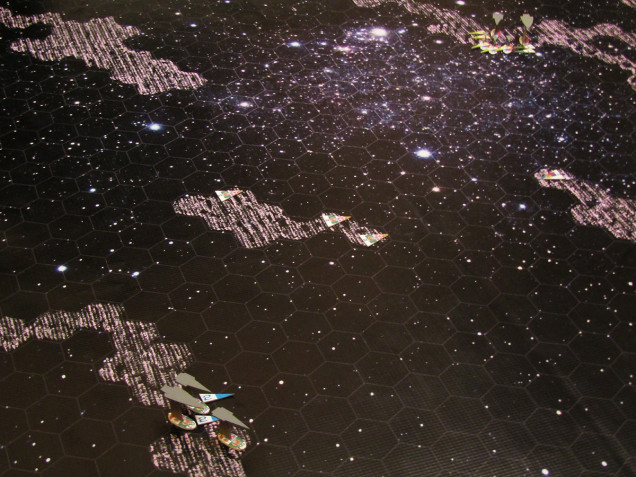 The French and Russian battlegroups make their initial approaches. Note the colored bands on the map. These are "density waves" in the vast ocean of ionized solar wind particles that permeate this whole area of space, the "helioshock boundary" where the solar wind of the nearby Onomoken star can no longer push against the interstellar medium and thus "piles up" in rippled waves just dense enough to partially interfere with a ship's targeting sensors. In game terms, each colored hex that a warship's intended line of sight / line of fire must enter adds +1 to the target difficulty. Each hex is 180 kilometers across.
The French and Russian battlegroups make their initial approaches. Note the colored bands on the map. These are "density waves" in the vast ocean of ionized solar wind particles that permeate this whole area of space, the "helioshock boundary" where the solar wind of the nearby Onomoken star can no longer push against the interstellar medium and thus "piles up" in rippled waves just dense enough to partially interfere with a ship's targeting sensors. In game terms, each colored hex that a warship's intended line of sight / line of fire must enter adds +1 to the target difficulty. Each hex is 180 kilometers across.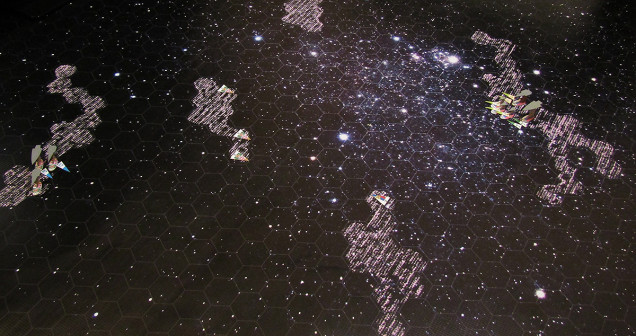 The ships continue to close. Here they are are about 3600 kilometers apart (2230+ miles), or roughly the distance between London and Jerusalem. All of Europe and part of the Middle East would easily fit between these two fleets.
The ships continue to close. Here they are are about 3600 kilometers apart (2230+ miles), or roughly the distance between London and Jerusalem. All of Europe and part of the Middle East would easily fit between these two fleets.REPORT: What was supposed to be a raid quickly turns into more of a pitched battle, as the Leclerc battlegroup and Lazarev task force make their initial approaches.
With much longer-ranged weapons, more gunnery, and more accurate sensors, the French of the Leclerc, Calais, and Corsica opt to keep the range open as long as they can, holding back and drilling the Russian corvettes with long-ranged laser fire to lighten the weight of the expected Russian torpedo spreads. The Russians, for their part, and to close the distance as quickly as possible, but are also using the vast, ionized bands of charged particles drifting throughout this helioshock boundary as “cover,” hoping they will take the edge off superior New Roman electronics.
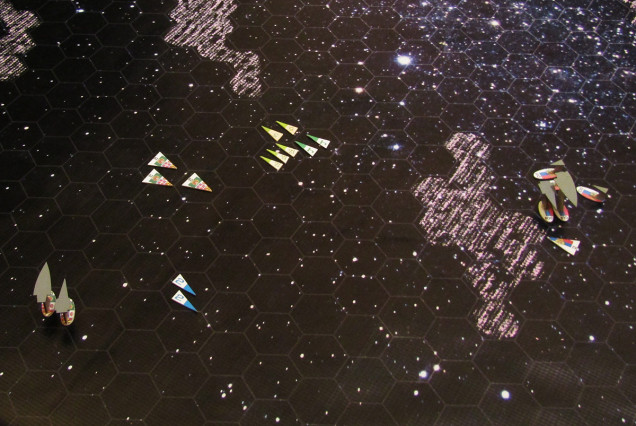 The fleets continue to close, the French (left) trying to keep the range long where their superior targeting electronics will give them an edge ... the Russians (right) trying to use ionized density waves as a kind of "cover."
The fleets continue to close, the French (left) trying to keep the range long where their superior targeting electronics will give them an edge ... the Russians (right) trying to use ionized density waves as a kind of "cover."At first, the tactics of both sides seem to be working reasonably well. As the Russians hoped, the opening French volley missed at a range of 3600 kilometers, partly due to the EM disruption of the helioshock ion bands. But as the Russians close, a second French volley engages the torpedo corvette K-121 at 2,200 kilometers, not quite crippling her but forcing her captain to break off the action.
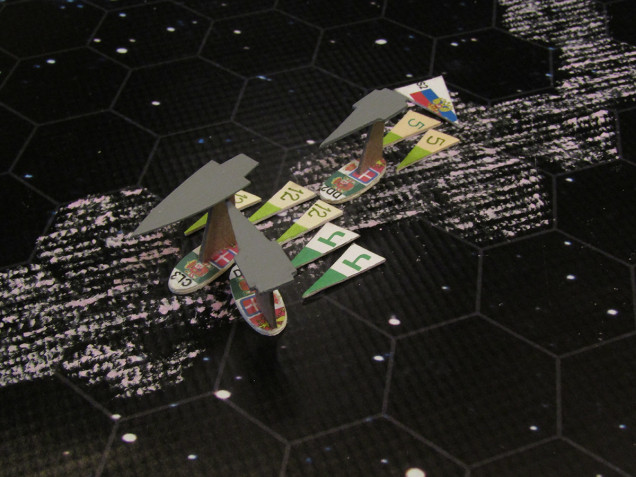 The Russians make the mistake of splitting their torpedo wave between the French flagship (NRS Leclerc - CL3) and one of her escorting destroyers (NRS Calais - DD2)
The Russians make the mistake of splitting their torpedo wave between the French flagship (NRS Leclerc - CL3) and one of her escorting destroyers (NRS Calais - DD2)For the French, however, things become unstuck from there. The Russian return volley, even at this relatively extended range, is devastating. The Lazarev and Syekyra have upgraded their targeting systems, and even shooting through a dense “pressure wave” of ionized solar wind, enough hits are scored on the starboard bow of the fragile destroyer Corsica to force her to break off. The damage isn’t actually that bad, but the hits just happen to set up a cascade failure through Corsica’s navigation computers and life support systems. Then again, perhaps no one is particularly eager to get in a really bloody fight this far out from any bases, colonies, or potential rescue.

































![TerrainFest 2024! Build Terrain With OnTableTop & Win A £300 Prize [Extended!]](https://images.beastsofwar.com/2024/10/TerrainFEST-2024-Social-Media-Post-Square-225-127.jpg)








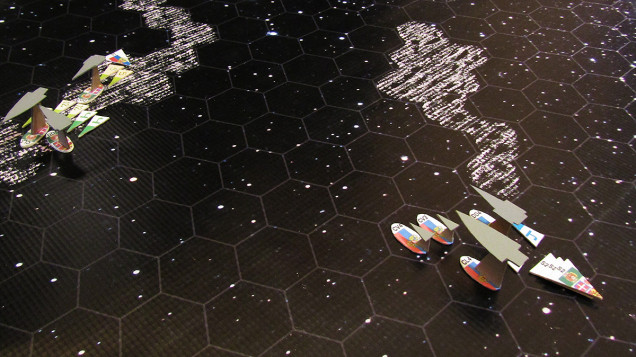

































@oriskany As I’ve stated before, I’m totally blown away by this system. It is reminiscent of Star Fleet Battles but totally unrecognizable due to your attention to the sort of physics minutiae that EVERY game should have. Unfortunately, we live in a world of simpletons who crave systems like Battlefleet Gothic.
Thanks very much, @cpauls1 – indeed, this system started off not so much as a list of things we wanted, but a list of things we DIDN’T want – either seen in other sci-fi starship games or sci-fi franchises we thought had serious creative or tactical flaws and shortcomings. Star Trek Starship Tactical Combat Simulator: Too granular Star Trek Star Fleet Battles: Too abstractified and simplified. Traveler: Starship design system is very realistic but an absolute nightmare. Leviathan: Over reliance on missiles and point defense – collateral blast rules are overpowered. Star Wars: Over reliance on fighters Star Wars: Cheesy… Read more »
More: I love the Traveller Fire, Fusion, and Steel system, and can’t help thinking this would dovetail into the design sequence of star faring ships. I find your system an excellent and realistic supplement to building EVERYTHING in the Traveller universe. The Traveller rules regarding combat are abstract, short or long, so I don’t see whyyou couldn’t plug Darkstar into that system.
We recently redesigned the whole system top-to-bottom for a much easier, less mind-numbing crunch (the old system was just too detailed, battles were taking 6-8 hours) – when we get done with all playtesting I really want to start experimenting with crossover ships from other sci fi universes. Traveler could definitely be a candidate. 😀
A bit of Traveller weaponry: I know you know Traveller, so wondered if sandcasters wouldn’t add complexity to the battlespace. They would certainly hinder lasers, and would diminish incoming torpedoes. They would also be a travelling obstacle
I know just a little Traveler – I once tried to actually design a ship in their system once and broke down sobbing. Our ships have navigation shields that protect them from very small obstacles like dust, microasteroids, etc … but “sandcasters” could definitely be worked into the ECM/Shielding upgrades. Our shields and ECM are not “force fields” like we see in so many space-opera sci-fi (that always fail to explain just how a “force field” is supposed to work). It considered to be a combined suite of electronic warfare, countermeasure, and gravitic refractive shielding that causes a weapon to… Read more »
Sandcasters are pretty much what it says on the label. They fire clouds of quartz sand to diffract lasers and ablate incoming warheads. I would imagine a huge cloud of the stuff would represent a hindrance to direct fire, would drift along in the direction it was fired and disperse over a short period of time as it is a shotgun sort of blast. Could make for some interesting tactical situations. Yup, the design sequence in FFS is a headache. I’ve got a tech level 11-12,jump-2 marine assault ship to build in the near future, only a 1000 tons, but… Read more »
Thanks, @cpauls1 – A lot to reply to in this post … Interesting idea about the quartz blasters. My only question would be the ballast tanks / storage / pulling that stuff around space until it was time to fire it. Other than that it sounds like a combination of our generic “mass driver” point defense systems (any small caliber weapons that shoot down torpedoes, aerospace craft, missiles, etc) and our ECM that either cause weapons to miss, refract, or prematurely detonate. I have tried design ships in Traveler (many years ago) and also (of all things) Steve Jackson’s car… Read more »